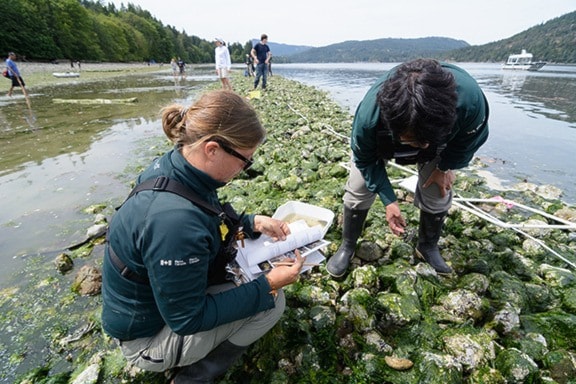Cowichan Valley students got the chance to apply traditional knowledge and science to learn about ancient clam gardens June 7-8.
“The day was full of learning, laughter and listening. I was inspired to see so many organizations come together to make [the event] possible: a fantastic example of what can happen when we all invest collaboratively in the education of our children and youth,” said Denise Augustine, aboriginal vice principal at the Cowichan Valley School District.
This restoration project bridges the gap between past and future, according to organizers.
Young people from the Stzuminus Band School, Alexander Elementary, Cowichan Secondary and Frances Kelsey Secondary schools took part, learning about clam gardens in and around Gulf Islands National Park Reserve.
They worked with First Nations elders, Parks Canada staff, scientists from Royal Roads University, and Food is Medicine in a day that saw them collecting samples from a clam garden wall for carbon dating, as well as learning how scientists apply ground-penetrating radar to learn more about these sites.
They also hopped into boats to take a look at clam beds, helped prepare food in a traditional pit cook, and learned about traditional language and customs.
Students from Cowichan Secondary really enjoyed it, according to Venessa MacDowell, one of the school’s vice-principals, and she was echoed by students who took part.
“I liked the whole trip and I want to learn more about the history,”, said Johnlee.
Victoria agreed, saying, “I learned about the history of clam gardens and the ancestors that first started them. I found this interesting. I didn’t realize stuff like this was going on for thousands of years.”
The shellfish gardens have been an important management tool for First Nations along Canada’s west coast going back far into history.
Recent scientific studies show that tended clam gardens produce four times as many butter clams and twice as many little neck clams as unmodified beaches.
It was the science that impressed some of the students.
“I learned how scientists map the ocean floor. I liked the teamwork involved in today. I hope to explore more places like this next year,” Joey T said.
Joey M was also impressed. “I learned about all the different types of species in a 1 foot square. So much marine life hidden between the rocks.”
Parks Canada is investing nearly $900,000 over five years in the Clam Garden Project as part of the Conservation and Restoration Program.
The event was held in partnership with the WSÁNEÆ School Board, School District 79, Stz’uminus Community School, Food is Medicine and Royal Roads University.
